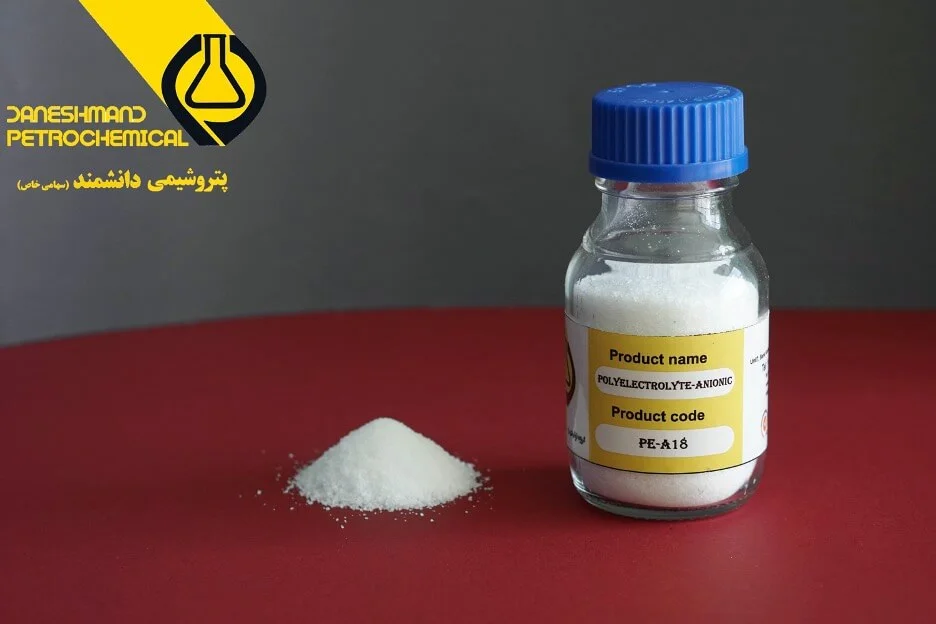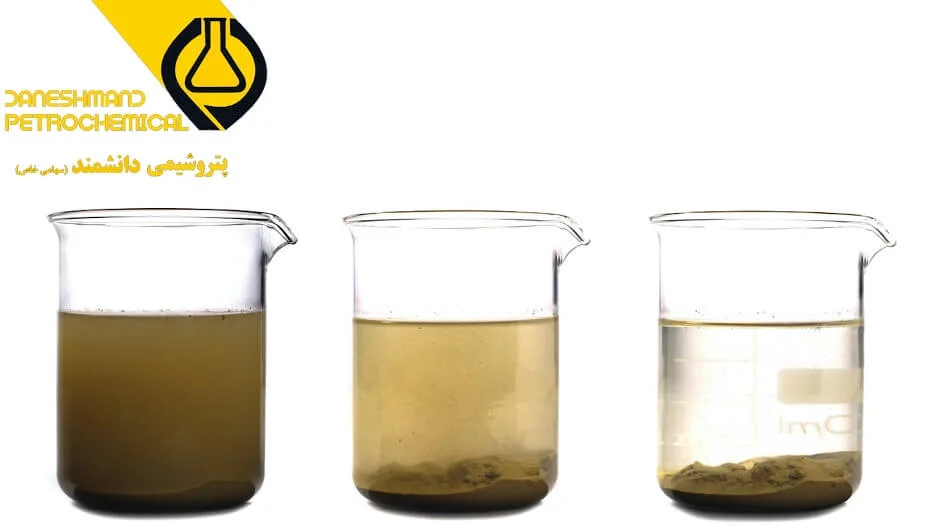Polyelectrolyte:
Polyelectrolyte is one of the best and most widely used flocculants, which is marketed under other names such as polyacrylamide PAM, which is marketed in three categories: anionic, cationic and nonionic.
These compounds have polymeric and electrolytic properties. In order to remove colloids and impurities suspended in water, sewage and wastewater, coagulation and flocculation methods are used. Other materials called coagulants are used to complete the coagulation process and to create larger and heavier flakes.
What is a polyelectrolyte:
Polyelectrolyte, or polyacrylamide (PAM), is a coagulation aid that converts flakes from the coagulation process into larger clots for better settling. This polymer compound is soluble in water and is formed from acrylamide molecules. It is not biodegradable and after a few weeks, it decomposes into organic compounds. Its appearance is a solid, white and odorless crystal that has the ability to dissolve in water, ethanol, ether and chloroform. The deposition rate of polyelectrolytes is about twice that of other coagulants and coagulants. Polyacrylamide is mostly used in powder form, but some customers use liquid polyelectrolyte to make things easier.
Analysis of Polyelectrolyte types
| A16 | A18 |
| A20 | K16 |
| K20 | |
MSDS of Polyelectrolyte types
| A16 | A18 |
| A20 | K16 |
| K20 | |

Types of polyelectrolyte:
Anionic flocculant or polyelectrolyte (negative charge)
Flocculant or cationic polyelectrolyte (positive charge)
Nanionic flocculant or polyelectrolyte (no charge means neutral)
Polyelectrolytes are present in the industrial grade and this product does not have an oral grade, if this product is used in water purification, for example, and it can not be eaten directly.
Anionic polyelectrolyte
Homopolymers and copolymers of acrylic acid with acrylamide that have a negative electric charge are called anionic polyacrylamide or anionic polyelectrolyte. This linear polymer is completely soluble in water and is synthesized under high temperature polymerization. It is almost insoluble in aliphatic solvents, acetone, benzene, ether and other organic solvents, but it has valuable properties. It can easily do flocculation, thickening, shear, dispersion, so in oil recycling, stone mills, mineral processing, coal washing, metallurgy, chemical coagulation, paper making, textile industry, sugar production, Used in pharmacy, environmental protection, concrete and building materials, agriculture and other industries.
Cationic polyelectrolyte
Cationic nanoparticles, homopolymers or copolymers with acrylamide have a positive charge, called cationic polyelectrolyte. These three monomers are cationic, and their cationic monomer, density, charge, and molecular weight are interdependent. These polyamines are made of epichlorohydrin and secondary amines such as dimethylamine.
Nanoic polyelectrolyte
Acrylamide homopolymers that are without or with neutrals are called nonionic or nionic polyelectrolytes.
Mechanism of action in water treatment
The mechanism of particle clotting by polymers can be divided into the following parts:
Polymer bridging
Charge neutralization
Depletion flocculation
The third part, which is the reduction of flocculation, depends on the presence of unabsorbed free polymers and is not very important in water treatment and is not addressed in this section. The first two depend on the adsorption of the polymer on the particle surface, and this will be discussed first.
Absorption on the surface
Adhesion of the polymer chains may occur if there is a bond between the polymer moieties and the particle surface. The interesting thing is that due to the large points of contact between the surface and the polymer, the bonds do not have to be very strong. In such long molecules, the possibility of separating all the units at the same time is very low, so this connection should be considered irreversible.
Bridging polymers
The polyelectrolytes that adhere to the particle surface have hanging tails and rings, these hanging points provide the conditions for the polymers attached to one particle to adhere to the surface of other particles.
Load neutralization
In many cases, impurity particles in water have a negative charge and therefore cationic polyelectrolytes are very useful. In these systems, very strong electrostatic bonding occurs, the particle charge is neutralized, and there is even the possibility of reversing the particle charge. Therefore, it is possible that clotting occurs as a result of a decrease in the surface charge of the particles and as a result of a reduction in repulsion between the particles.
How it works
According to the test jar, remove the desired amount of powder and turn it into a liquid, then add it to the desired solution and after stirring, it starts to clot and settles.

Production of polyelectrolytes
Liquid phase polymerization of acrylamide or acrylic acid is used to form polyelectrolytes. Polymerization was performed in aqueous solutions at a temperature of approximately 60 ° C. The concentration of monomers is set at 40% (containing 36% acrylamide and 4% acrylic acid). This works only by using the induction properties of radiation and microwave heating to form linear polymer chains with good solubility in water. The concentration of residual monomer decreased and increased the flocculation capacity of the obtained polymers. Acrylamide, which is easily produced, has unique chemical properties that make it easy to synthesize high molecular weight polymers.
Properties of polyacrylamide
Polyacrylamides are polymers whose repeating units contain a group of electrolytes. These groups are separated in aqueous solutions (water) and charge the polymers. Therefore, the properties of polyacrylamide are similar to both electrolytes (salts) and polymers (compounds with high molecular weight) and are sometimes called polymalts.
How to choose the right
The correct choice of flocculant depends on the electrical charge of the suspended colloids in solution. If the colloids are uncharged, nionic and if the electric charge of the colloids is negative, cation should be used and also if the electric charge of the colloids is positive, anionic should be used. Electrostatic gravitational force is very important for the formation of flocks or clots between the suspended particles of colloids and flocculants, because this force is created by using the gravitational force between the uneven loads of colloids and flocculants.
Application of polyacrylamide
Polyacrylamide or PAM has different applications in different industries. The following are its applications:
Water and wastewater treatment
Industrial effluent treatment
Paper making (preparation of pulp and factory effluent)
Food industry factories
Oil and gas and petrochemicals
Excavation
Dyeing
leather manufacturing Production of agricultural pesticides

